Exploring the Relationship between Urbanization and the Eco-Environment: A Case Study of Beijing
Abstract
:1. Introduction
2. Materials and Methods
2.1. Study Area
2.2. Data Source and Pre-Processing
2.3. Methods
2.3.1. Hierarchical-Based Classification for Time Series Landsat Images
2.3.2. Constructing the Comprehensive Index System of Urbanization and the Eco-Environment
2.3.3. Constructing the Coupling Model of Urbanization and the Eco-Environment
3. Results
3.1. Land Cover Change Analyses
3.2. Calculation and Evaluation of the Coupling Coordination Degree
3.2.1. The Coupling Coordination Degree in Beijing
3.2.2. The Coupling Coordination Degree in Functional Zones
4. Discussion
5. Conclusions
Author Contributions
Funding
Acknowledgments
Conflicts of Interest
References
- Zhao, Y.; Wang, S.; Ge, Y.; Liu, Q.; Liu, X. The spatial differentiation of the coupling relationship between urbanization and the eco-environment in countries globally: A comprehensive assessment. Ecol. Modell. 2017, 360, 313–327. [Google Scholar] [CrossRef]
- Riley, S.P.D.; Busteed, G.T.; Kats, L.B.; Vandergon, T.L.; Lee, L.F.S.; Dagit, R.G.; Kerby, J.L.; Fisher, R.N.; Sauvajot, R.M. Effects of urbanization on the distribution and abundance of amphibians and invasive species in southern California streams. Conserv. Biol. 2005, 19, 1894–1907. [Google Scholar] [CrossRef]
- Kumazawa, N. A Study of Impact of Urbanization on Ephemeral Streams in Headwater Watersheds in Eastern Pima County, AZ; The University of Arizona: Tucson, AZ, USA, 2004. [Google Scholar]
- Singh, P.; Kikon, N.; Verma, P. Impact of land use change and urbanization on urban heat island in Lucknow city, Central India. A remote sensing based estimate. Sustain. Cities Soc. 2017, 32, 100–114. [Google Scholar] [CrossRef]
- Hall, R.I.; Leavitt, P.R.; Quinlan, R.; Dixit, A.S.; Smol, J.P. Effects of agriculture, urbanization, and climate on water quality in the northern Great Plains. Limnol. Oceanogr. 1999, 44, 739–756. [Google Scholar] [CrossRef] [Green Version]
- Paul, M.J.; Meyer, J.L. Streams in the urban landscape. Annu. Rev. Ecol. Syst. 2001, 32, 333–365. [Google Scholar] [CrossRef]
- Lederbogen, F.; Kirsch, P.; Haddad, L.; Streit, F.; Tost, H.; Schuch, P.; Wüst, S.; Pruessner, J.C.; Rietschel, M.; Deuschle, M.; et al. City living and urban upbringing affect neural social stress processing in humans. Nature 2011, 474, 498–501. [Google Scholar] [CrossRef]
- Service, C.R. China’s Economic Rise: History, Trends, Challenges, and Implications for the United States. 2019. Available online: https://fas.org/sgp/crs/row/RL33534.pdf (accessed on 7 November 2019).
- Chow, G.C.; Li, K. China’s Economic Growth. Ecomonic Dev. Cult. Chang. 2002, 51, 247–256. [Google Scholar] [CrossRef]
- Ai, J.; Feng, L.; Dong, X.; Zhu, X.; Li, Y. Exploring coupling coordination between urbanization and ecosystem quality (1985–2010): a case study from Lianyungang City, China. Front. Earth Sci. 2016, 10, 527–545. [Google Scholar] [CrossRef]
- Bao, C.; Fang, C.-L. Water resources constraint force on urbanization in water deficient regions: A case study of the Hexi Corridor, arid area of NW China. Ecol. Econ. 2007, 62, 508–517. [Google Scholar] [CrossRef]
- Jaeger, J.A.G.; Bertiller, R.; Schwick, C.; Kienast, F. Suitability criteria for measures of urban sprawl. Ecol. Indic. 2010, 10, 397–406. [Google Scholar] [CrossRef]
- Lu, Q.; Liang, F.; Bi, X.; Duffy, R.; Zhao, Z. Effects of urbanization and industrialization on agricultural land use in Shandong Peninsula of China. Ecol. Indic. 2011, 11, 1710–1714. [Google Scholar] [CrossRef]
- Fan, J.; Tao, A.; Ren, Q. On the Historical Background, Scientific Intentions, Goal Orientation, and Policy Framework of Major Function-Oriented Zone Planning in China. J. Resour. Ecol. 2010, 1, 289–299. [Google Scholar]
- Gu, A.; Teng, F.; Wang, Y. China energy-water nexus: Assessing the water-saving synergy effects of energy-saving policies during the eleventh Five-year Plan. Energy Convers. Manag. 2014, 85, 630–637. [Google Scholar] [CrossRef]
- Howard, E. To-Morrow: A Peaceful Path to Real Reform; Swan Sonnenschein: London, UK, 1898. [Google Scholar]
- Corbusier, L. La Ville Radieuse. In Proceedings of the Editions de l’Architecture d’Aujourd’hui; Editions de l'Architecture D'aujourd'hui: Boulogne, France, 1935. [Google Scholar]
- Wright, F.L. The Disappearing City; W.F. Payson: New York, NY, USA, 1932. [Google Scholar]
- Wang, S.; Ma, H.; Zhao, Y. Exploring the relationship between urbanization and the eco-environment—A case study of Beijing-Tianjin-Hebei region. Ecol. Indic. 2014, 45, 171–183. [Google Scholar] [CrossRef]
- Grossman, G.M.; Krueger, A.B. Economic Growth and the Environment Author (s): Gene M. Grossman and Alan B. Krueger Reviewed work (s): Published by: Oxford University Press. Q. J. Econ. 1995, 110, 353–377. [Google Scholar] [CrossRef]
- Ozatac, N.; Gokmenoglu, K.K.; Taspinar, N. Testing the EKC hypothesis by considering trade openness, urbanization, and financial development: the case of Turkey. Environ. Sci. Pollut. Res. 2017, 24, 16690–16701. [Google Scholar] [CrossRef]
- Saboori, B.; Sulaiman, J. Environmental degradation, economic growth and energy consumption: Evidence of the environmental Kuznets curve in Malaysia. Energy Policy 2013, 60, 892–905. [Google Scholar] [CrossRef]
- Kijima, M.; Nishide, K.; Ohyama, A. Economic models for the environmental Kuznets curve: A survey. J. Econ. Dyn. Control 2010, 34, 1187–1201. [Google Scholar] [CrossRef]
- Nonomura, A.; Kitahara, M.; Masuda, T. Impact of land use and land cover changes on the ambient temperature in a middle scale city, Takamatsu, in Southwest Japan. J. Environ. Manag. 2009, 90, 3297–3304. [Google Scholar] [CrossRef]
- Vargo, J.; Habeeb, D.; Stone, B. The importance of land cover change across urban-rural typologies for climate modeling. J. Environ. Manag. 2013, 114, 243–252. [Google Scholar] [CrossRef]
- Fang, C.; Wang, J. A theoretical analysis of interactive coercing effects between urbanization and eco-environment. Chinese Geogr. Sci. 2013, 23, 147–162. [Google Scholar] [CrossRef]
- Yin, K.; Wang, R.; An, Q.; Yao, L.; Liang, J. Using eco-efficiency as an indicator for sustainable urban development: A case study of Chinese provincial capital cities. Ecol. Indic. 2014, 36, 665–671. [Google Scholar] [CrossRef]
- Li, Y.; Li, Y.; Zhou, Y.; Shi, Y.; Zhu, X. Investigation of a coupling model of coordination between urbanization and the environment. J. Environ. Manag. 2012, 98, 127–133. [Google Scholar] [CrossRef] [PubMed]
- He, J.; Wang, S.; Liu, Y.; Ma, H.; Liu, Q. Examining the relationship between urbanization and the eco-environment using a coupling analysis: Case study of Shanghai, China. Ecol. Indic. 2017, 77, 185–193. [Google Scholar] [CrossRef]
- Patra, S.; Sahoo, S.; Mishra, P.; Mahapatra, S.C. Impacts of urbanization on land use /cover changes and its probable implications on local climate and groundwater level. J. Urban Manag. 2018, 7, 70–84. [Google Scholar] [CrossRef]
- Mantas, V.M.; Marques, J.C.; Pereira, A.J.S.C. A geospatial approach to monitoring impervious surfaces in watersheds using Landsat data (the Mondego Basin, Portugal as a case study). Ecol. Indic. 2016, 71, 449–466. [Google Scholar] [CrossRef]
- Gu, W.; Guo, J.; Fan, K.; Chan, E.H.W. Dynamic Land Use Change and Sustainable Urban Development in a Third-tier City within Yangtze Delta. Procedia Environ. Sci. 2016, 36, 98–105. [Google Scholar] [CrossRef] [Green Version]
- Wurm, M.; D’Angelo, P.; Reinartz, P.; Taubenböck, H. Investigating the applicability of Cartosat-1 DEMs and topographic maps to localize large-area urban mass concentrations. IEEE J. Sel. Top. Appl. Earth Obs. Remote Sens. 2014, 7, 4138–4152. [Google Scholar] [CrossRef]
- García-Ayllón, S. Retro-diagnosis methodology for land consumption analysis towards sustainable future scenarios: Application to a mediterranean coastal area. J. Clean. Prod. 2018, 195, 1408–1421. [Google Scholar] [CrossRef]
- Inostroza, L.; Hamstead, Z.; Spyra, M.; Qhreshi, S. Beyond urban–rural dichotomies: Measuring urbanisation degrees in central European landscapes using the technomass as an explicit indicator. Ecol. Indic. 2019, 96, 466–476. [Google Scholar] [CrossRef]
- Stylianidis, E.; Karanikolas, N.; Kaimaris, D. A GIS for urban sustainability indicators in spatial planning. Int. J. Sustain. Dev. Plan. 2012, 7, 1–13. [Google Scholar] [CrossRef]
- Chen, Y.; Su, W.; Li, J.; Sun, Z. Hierarchical object oriented classification using very high resolution imagery and LIDAR data over urban areas. Adv. Sp. Res. 2009, 43, 1101–1110. [Google Scholar] [CrossRef]
- Dinis, J.; Navarro, A.; Soares, F.; Santos, T. Hierarchical object-based classification of dense urban areas by integrating high spatial resolution satellite images and lidar elevation data. Int. Arch. Photogramm. Remote Sens. 2010, 38. [Google Scholar]
- Lu, D.; Hetrick, S.; Moran, E.; Li, G. Application of Time Series Landsat Images to Examining Land-use/Land-cover Dynamic Change. Photogramm. Eng. Remote Sens. 2012, 78, 747–755. [Google Scholar] [CrossRef] [Green Version]
- Lu, D.; Li, G.; Moran, E.; Hetrick, S. Spatiotemporal analysis of land-use and land-cover change in the Brazilian Amazon. Int. J. Remote Sens. 2013, 34, 5953–5978. [Google Scholar] [CrossRef] [Green Version]
- Jensen, J.R. Introductory Digital Image Processing: A Remote Sensing Prospective, 2nd ed.; Prentice Hall, Inc.: Upper Saddle River, NJ, USA, 1996. [Google Scholar]
- Rouse, J.W.; Hass, R.H.; Schell, J.A.; Deering, D.W. Monitoring vegetation systems in the great plains with ERTS. In Third Earth Resources Technology Satellite (ERTS) Symposium; NASA: Washington, DC, USA, 1974; Volume 1, p. 309. [Google Scholar]
- Zha, Y.; Gao, J.; Ni, S. Use ofnormalized difference built-up index in automatically mapping urban areas from TM imagery. Int. J. Remote Sens. 2003, 24, 583–594. [Google Scholar] [CrossRef]
- Xu, H. Modification of normalised difference water index (NDWI) to enhance open water features in remotely sensed imagery. Int. J. Remote Sens. 2006, 27, 3025–3033. [Google Scholar] [CrossRef]
- Lucas, L.; Janssen, F.; Vanderwel, F.J.M. Van Der Accuracy Assessment of Satellite Derived Land-Cover Data: A review. Photogramm. Eng. Remote Sens. 1994, 60, 419–426. [Google Scholar]
- Zhang, H.; Zhou, L.G.; Chen, M.N.; Ma, W.C. Land use dynamics of the fast-growing Shanghai Metropolis, China (1979–2008) and its implications for land use and urban planning policy. Sensors 2011, 11, 1794–1809. [Google Scholar] [CrossRef]
- Zhao, Y.; Zhang, K.; Fu, Y.; Zhang, H. Examining land-use/land-cover change in the lake dianchi watershed of the Yunnan-Guizhou plateau of Southwest China with remote sensing and GIS techniques: 1974-2008. Int. J. Environ. Res. Public Health 2012, 9, 3843–3865. [Google Scholar] [CrossRef]
- Zhou, D.; Tian, Y.; Jiang, G. Spatio-temporal investigation of the interactive relationship between urbanization and ecosystem services: Case study of the Jingjinji urban agglomeration, China. Ecol. Indic. 2018, 95, 152–164. [Google Scholar] [CrossRef]
- Chen, Y.; Yu, J.; Khan, S. The spatial framework for weight sensitivity analysis in AHP-based multi-criteria decision making. Environ. Model. Softw. 2013, 48, 129–140. [Google Scholar] [CrossRef]
- Hernández, S.; Baldomir, A.; Díaz, J.; Pereira, F. An enhanced formulation of the maximum entropy method for structural optimization. Comput. Mater. Contin. 2012, 32, 219–239. [Google Scholar]
- Feng, Z.; Zhang, J.; Wei, H.; Zhai, L. Dynamic changes of hemeroby degree based on the land cover classification: A case study in Beijing. Chinese J. Ecol. 2017, 36, 508–516. [Google Scholar]
- Bertalany, L. General System Theory: Foundations, Development, Applications; George Braziller, Inc.: New York, NY, USA, 1969. [Google Scholar]
- Chisholm, M. General Systems Theory and Geography. Trans. Inst. Br. Geogr. 1967, 42, 45–52. [Google Scholar] [CrossRef]
- Strahler, A.N. Systems theory in physical geography. Phys. Geogr. 1980, 1, 1–27. [Google Scholar] [CrossRef]
- Haigh, M.J. Geography and general system theory, philosophical homologies and current practice. Geoforum 1985, 16, 191–203. [Google Scholar] [CrossRef]
- Jiang, B.; Gimblett, H.R. An agent-based approach to environmental and urban systems. In Integrating Geographic Information Systems and Agent-Based Techniques for Simulating Social and Ecological Processes; Oxford University Press: New York, NY, USA, 2002; pp. 171–189. [Google Scholar]
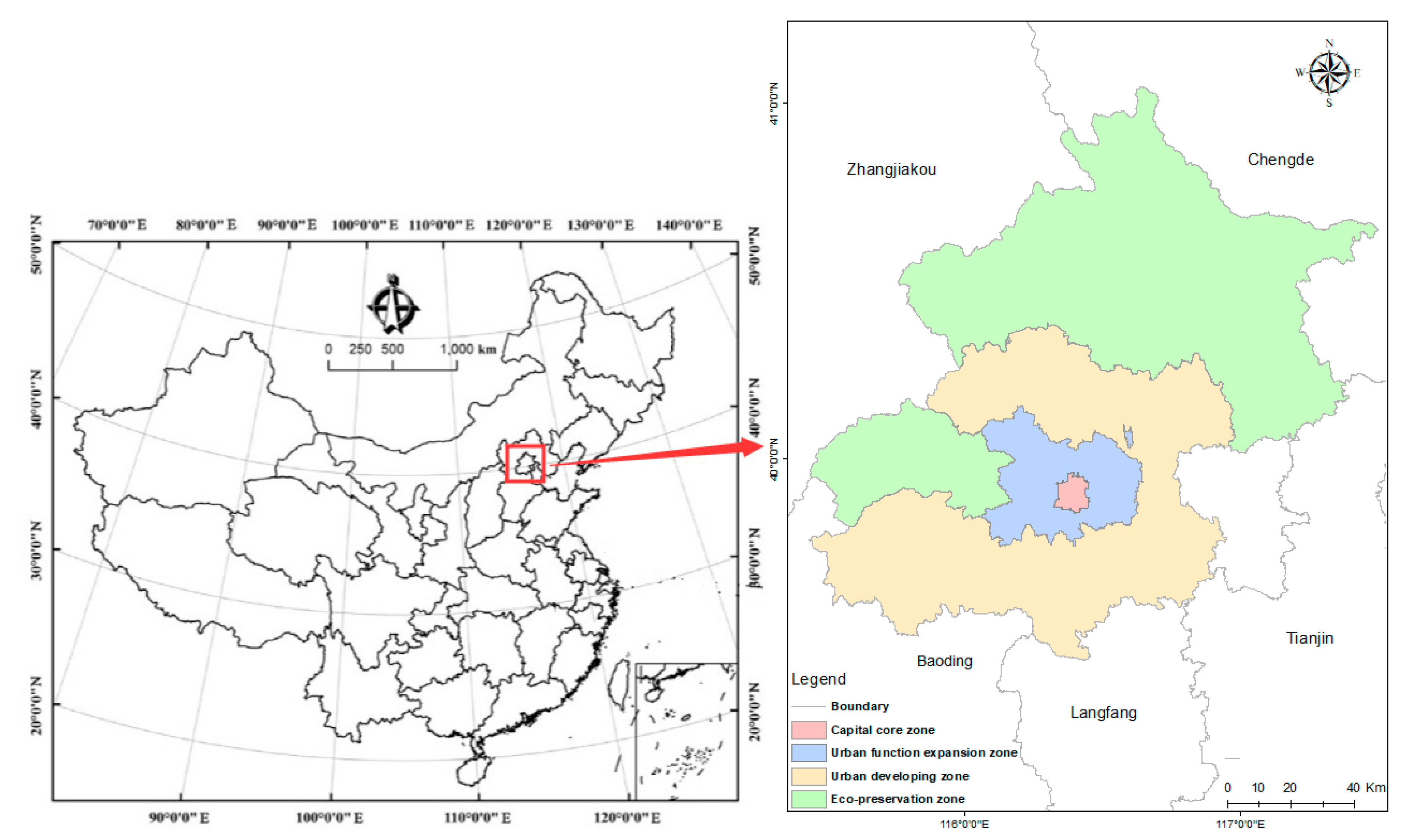
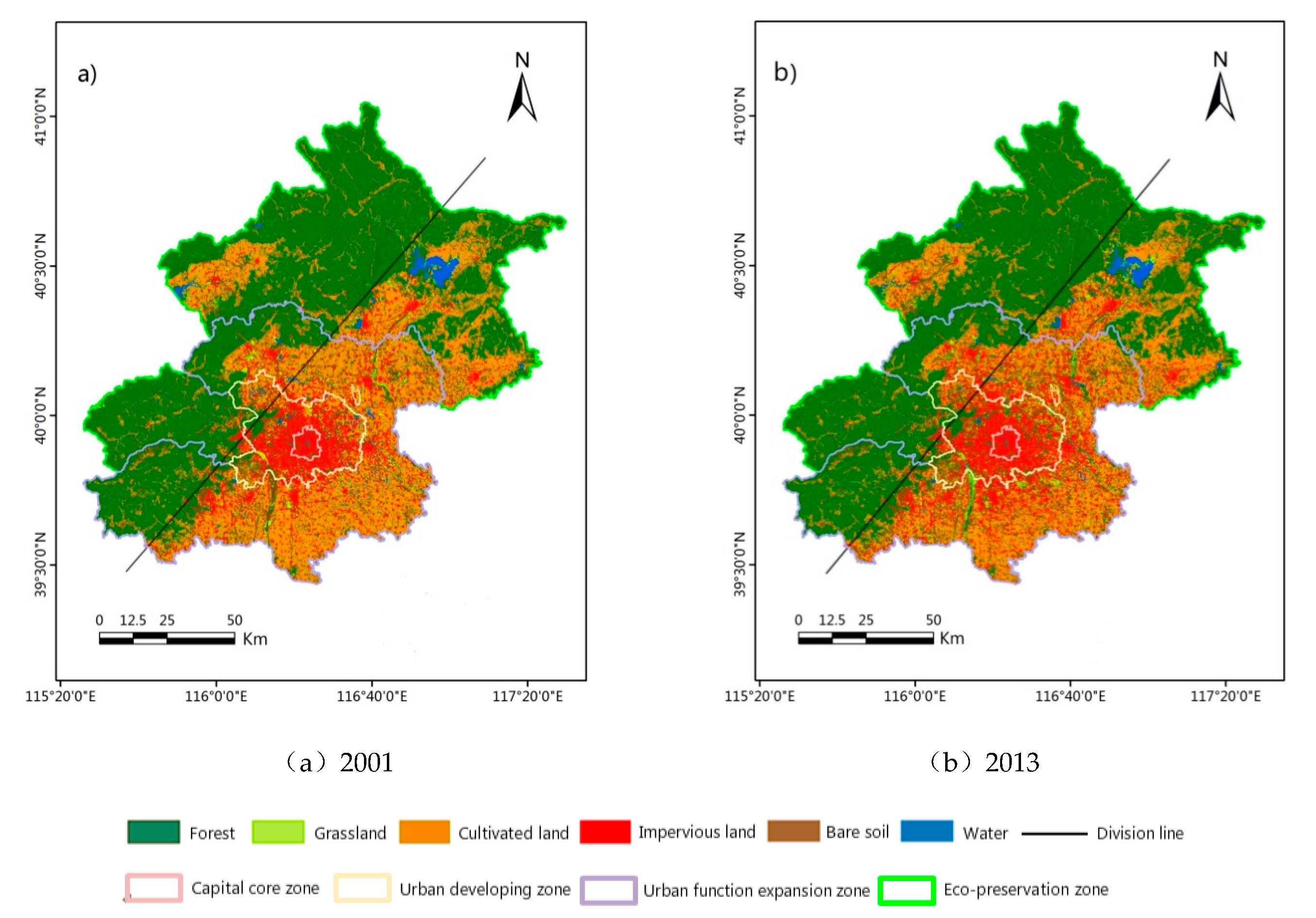
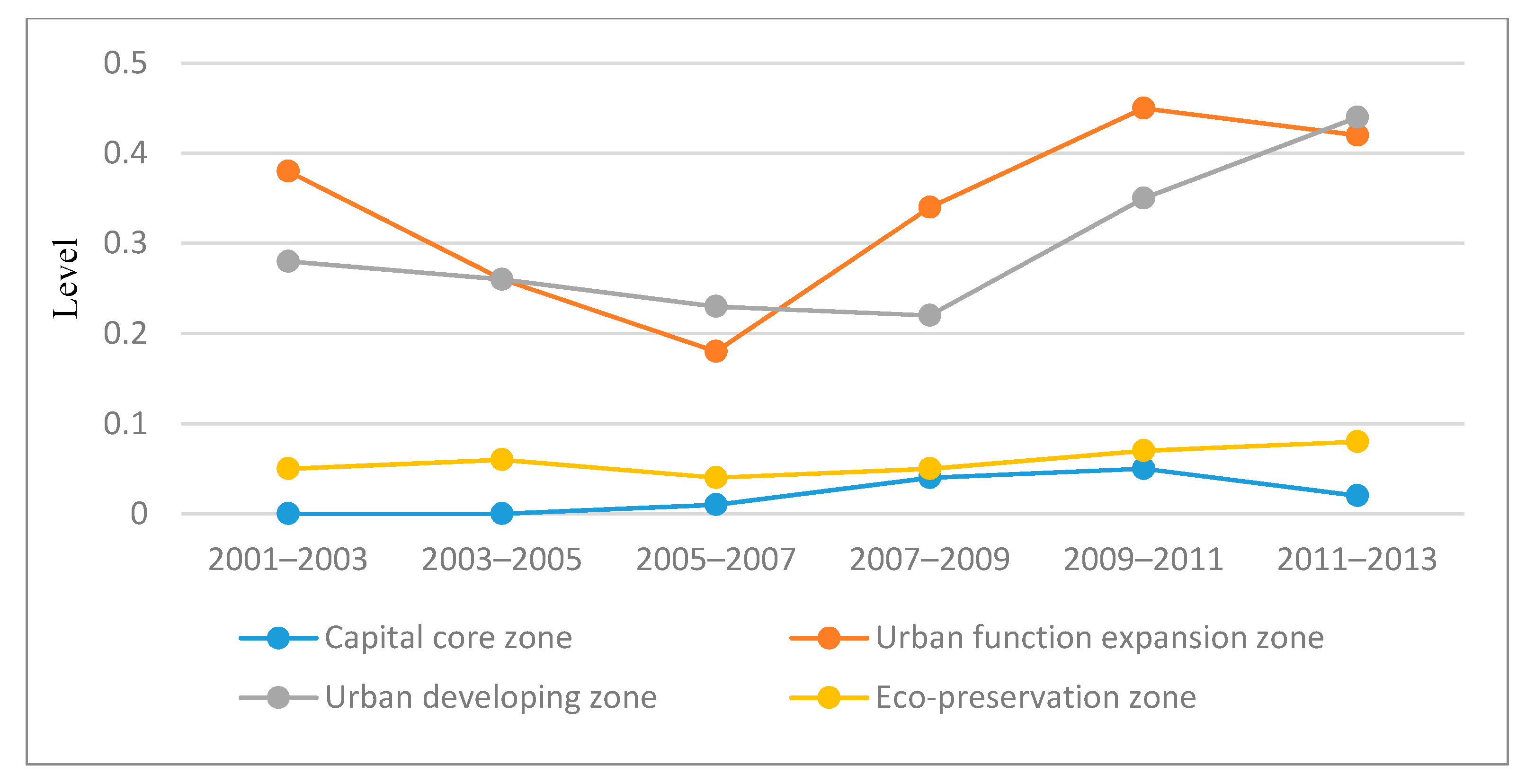
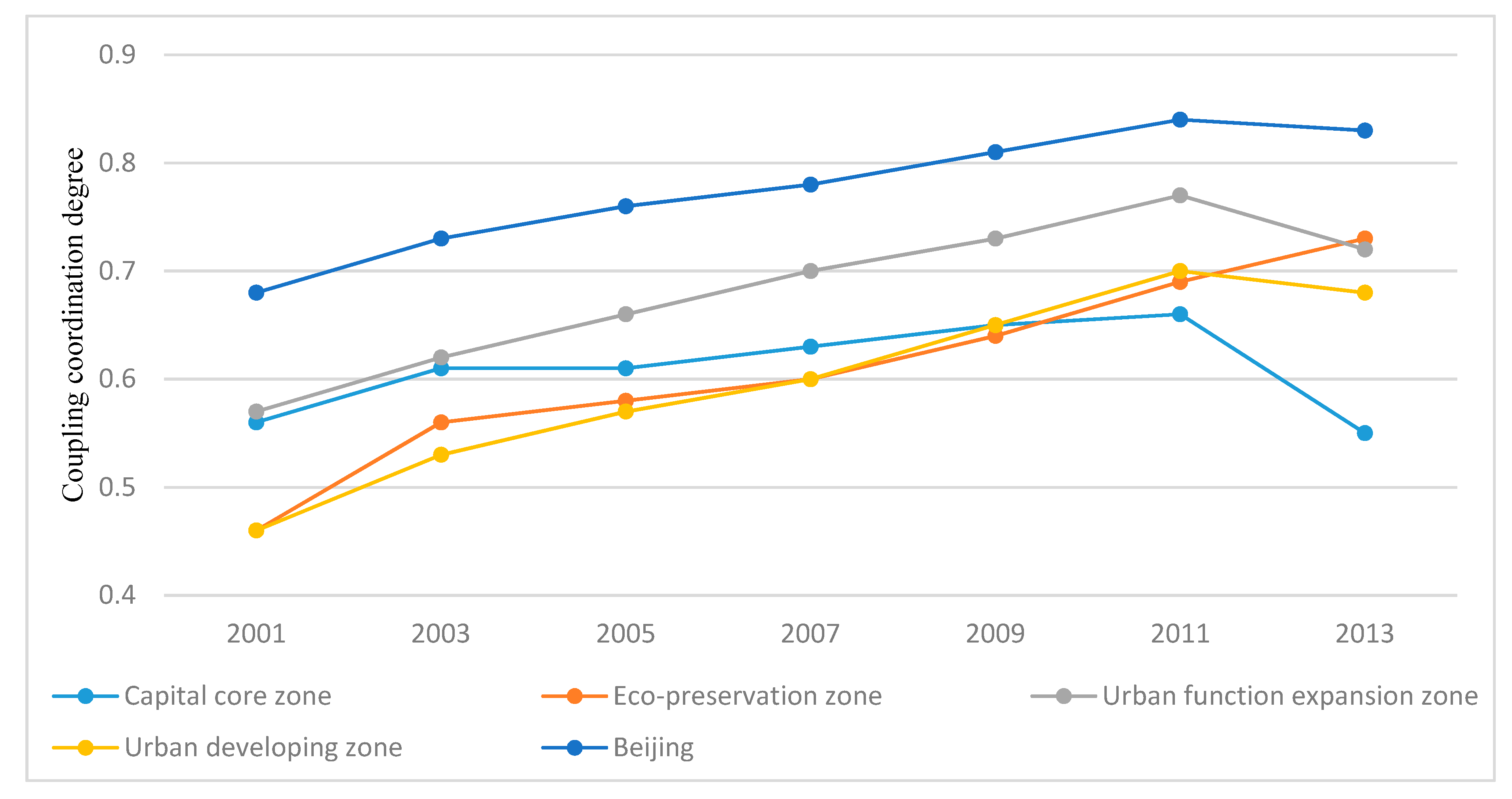
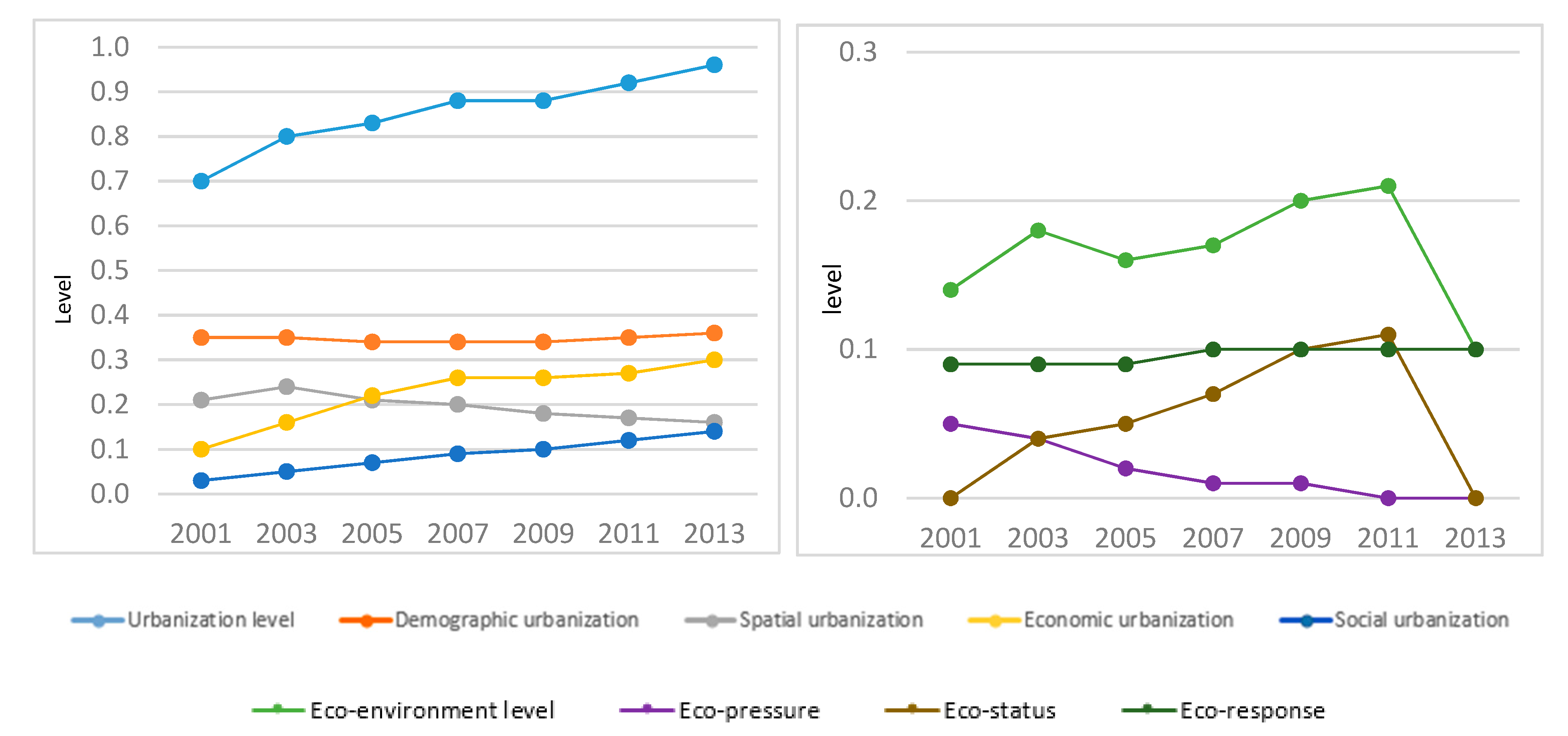
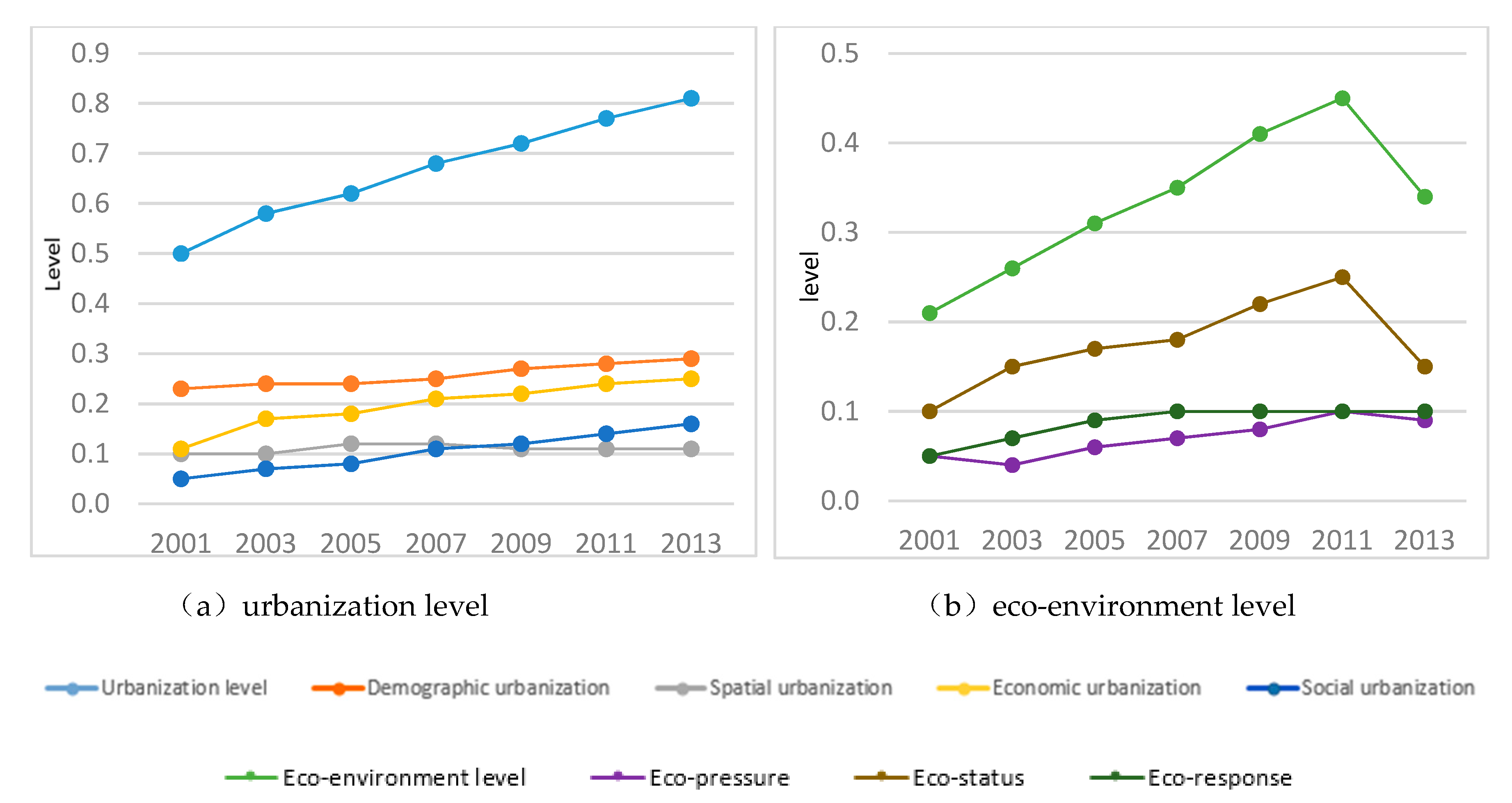
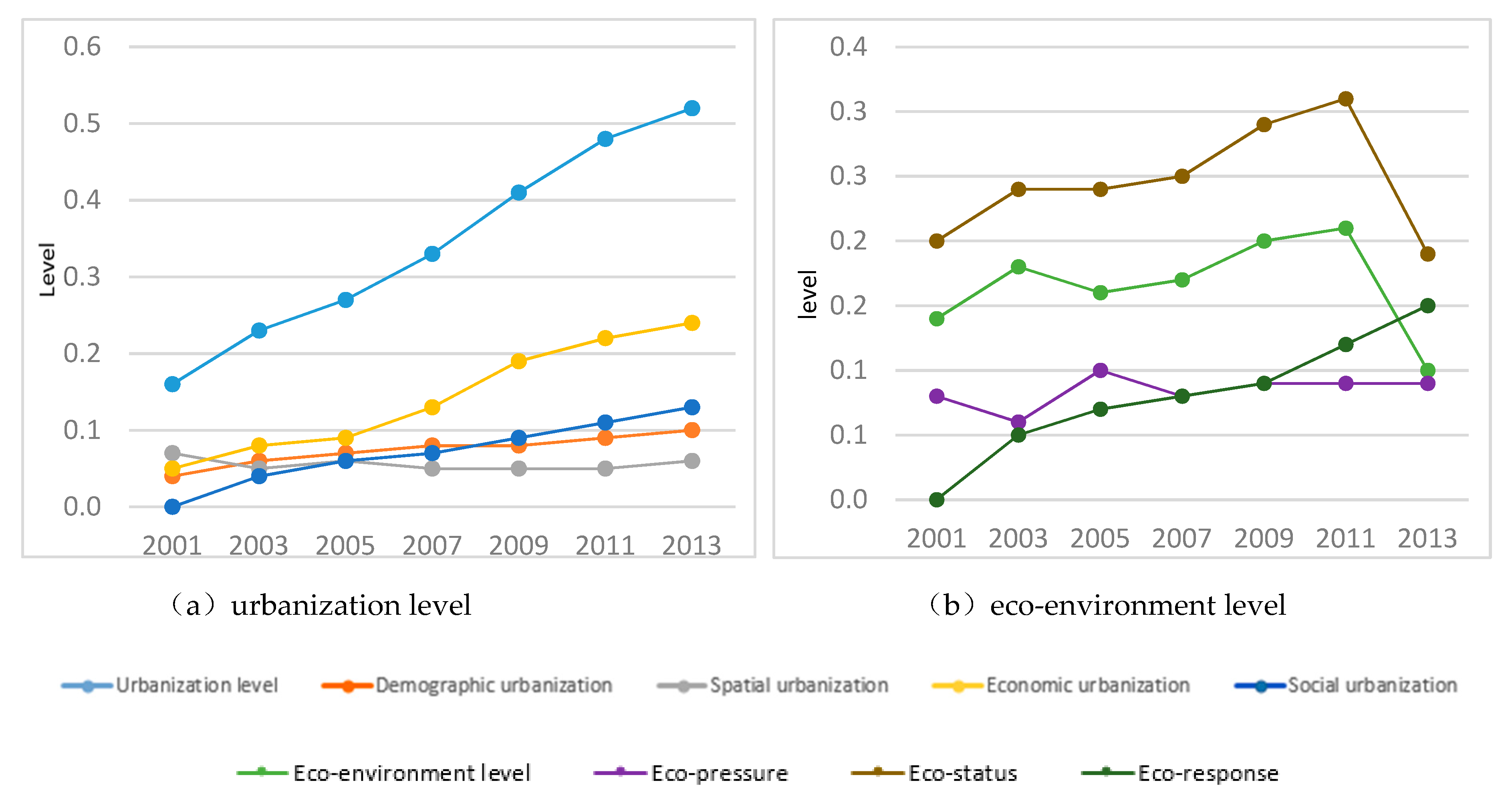

| Data | Time | Format |
|---|---|---|
| Landsat5 TM | 2001.08.31–2003.09.17 2005.08.06–2007.08.28 2009.09.02–2011.08.26 | Raster |
| Landsat8 OLI | 2013.09.01 | Raster |
| Administrative boundary | 2015 | Vector |
| Beijing Statistic Yearbook | 2001–2013 | Document |
| District Statistic Yearbook | 2001–2013 | Document |
| Beijing Environment Bulletin | 2001–2013 | Document |
| Google Earth Image | 2007 | Raster |
| Geographic Condition Monitoring data (Beijing–Tianjin–Hebei) | 2007/2015 | Vector |
| Primary Index | FA | FA1 | FA2 | FA3 | FA4 | Secondary Index | FA | FA1 | FA2 | FA3 | FA4 |
|---|---|---|---|---|---|---|---|---|---|---|---|
| Demographic urbanization | 0.33 | 0.36 | 0.35 | 0.31 | 0.30 | Population density (persons/km2) | 0.31 | 0.44 | 0.28 | 0.31 | 0.27 |
| Percentage of non-agriculture households (%) | 0.29 | 0.10 | 0.27 | 0.30 | 0.27 | ||||||
| Percentage of urban employed units (%) | 0.40 | 0.46 | 0.45 | 0.39 | 0.46 | ||||||
| Spatial urbanization | 0.22 | 0.24 | 0.20 | 0.25 | 0.26 | Percentage of impervious surfaces (%) | 0.49 | 0.57 | 55 | 0.41 | 0.43 |
| Percentage of commercial housing among impervious surfaces (%) | 0.51 | 0.43 | 0.45 | 0.59 | 0.57 | ||||||
| Economic urbanization | 0.28 | 0.25 | 0.29 | 0.29 | 0.29 | GDP per capita (Yuan) | 0.23 | 0.24 | 0.29 | 0.25 | 0.29 |
| Average investment in fixed assets (100 million) | 0.28 | 0.29 | 0.26 | 0.31 | 0.23 | ||||||
| Average industrial output (Yuan) | 0.22 | 0.25 | 0.20 | 0.20 | 0.30 | ||||||
| Proportion of the added value of the tertiary industry to GDP (%) | 0.27 | 0.22 | 0.25 | 0.24 | 0.18 | ||||||
| Social urbanization | 0.18 | 0.16 | 0.16 | 0.16 | 0.16 | Disposal income per capita (Yuan) | 0.23 | 0.26 | 0.29 | 0.22 | 0.22 |
| Number of health institutions per 10, 000 people | 0.31 | 0.26 | 0.22 | 0.30 | 0.32 | ||||||
| Average retail sales of consumer goods per capita (Yuan) | 0.28 | 0.27 | 0.26 | 0.28 | 0.28 | ||||||
| Number of PCs per 100 households | 0.18 | 0.21 | 0.23 | 0.20 | 0.18 | ||||||
| Eco-pressure | 0.29 | 0.31 | 0.30 | 0.25 | 0.27 | Human disturbance index | 0.35 | 0.38 | 0.40 | 0.33 | 0.35 |
| Percentage of impervious surfaces (%) | 0.30 | 0.29 | 0.23 | 0.33 | 0.31 | ||||||
| Energy consumption per capita (t) | 0.39 | 0.37 | 0.41 | 0.38 | 0.38 | ||||||
| Eco-status | 0.49 | 0.45 | 0.49 | 0.50 | 0.47 | Percentage of forests (%) | 0.25 | 0.29 | 0.27 | 0.26 | 0.24 |
| Percentage of grasslands (%) | 0.18 | 0.17 | 0.15 | 0.17 | 0.20 | ||||||
| Habitat quality index | 0.30 | 0.31 | 0.32 | 0.30 | 0.30 | ||||||
| Days for air quality better than the second level (days) | 0.27 | 0.25 | 0.27 | 0.27 | 0.28 | ||||||
| Eco-response | 0.22 | 0.24 | 0.21 | 0.25 | 0.26 | Growth rate of green areas (%) | 0.58 | 0.53 | 0.58 | 0.55 | 0.54 |
| Decontamination rate of urban refuse (%) | 0.42 | 0.47 | 0.43 | 0.45 | 0.46 |
| Primary Division | Secondary Division | Tertiary Division | ||
|---|---|---|---|---|
| Balanced development | 0.8 < D ≤ 1 | Superiorly balanced development | g(E)–f(I) > 0.1 | Superiorly balanced development with urbization lagged |
| f(I)–g(E) > 0.1 | Superiorly balanced development with environment lagged | |||
| 0 ≤ f(I)–g(E) ≤ 0.1 | Superiorly balanced development of urbanization and environment | |||
| Transitional development | 0.5 < D ≤ 0.8 | Basically balanced development | g(E)–f(I) > 0.1 | Basically balanced development with urbanization lagged |
| f(I)–g(E) > 0.1 | Basically balanced development with environment lagged | |||
| 0 ≤ f(I)–g(E) ≤ 0.1 | Basically balanced development of urbanization and environment | |||
| Imbalanced development | 0.3 < D ≤ 0.5 | Slightly imbalanced development | g(E)–f(I) > 0.1 | Slightly imbalanced development with urbanization hindered |
| f(I)–g(E) > 0.1 | Slightly imbalanced development with environment hindered | |||
| 0 ≤ f(I)–g(E) ≤ 0.1 | Slightly imbalanced development of urbanization and environment | |||
| 0 <D ≤ 0.3 | Seriously imbalanced development | g(E)–f(I) > 0.1 | Seriously imbalanced with urbanization hindered | |
| f(I)–g(E) > 0.1 | Seriously imbalanced with environment hindered | |||
| 0 ≤ f(I)–g(E) ≤ 0.1 | Serious imbalance of urbanization and environment |
| Dynamic Index | K | LC | |||||
|---|---|---|---|---|---|---|---|
| Land Cover | Forests | Grasslands | Cultivated Land | Impervious Surfaces | Bare Land | Water | - |
| Capital core zone | 0.32 | 0.92 | 0.00 | −0.07 | 0.00 | −0.16 | 0.11 |
| Urban function expansion zone | 2.24 | 2.29 | −4.54 | 0.24 | −7.76 | −2.69 | 1.63 |
| Urban developing zone | 0.79 | 3.87 | −2.26 | 2.65 | −5.27 | −1.52 | 1.39 |
| Eco-preservation zone | 0.09 | 1.21 | −0.70 | 1.35 | −1.52 | −0.76 | 0.26 |
| Year | FA | FA1 | FA2 | FA3 | FA4 |
|---|---|---|---|---|---|
| 2001 | BB | BB-EL | BB-EL | SU-UL | SU-UL |
| 2003 | BB | BB-EL | BB-EL | BB-UL | BB-UL |
| 2005 | BB | BB-EL | BB-EL | BB-UL | BB-UL |
| 2007 | BB | BB-EL | BB-EL | BB | BB-UL |
| 2009 | SB | BB-EL | BB-EL | BB | BB-UL |
| 2011 | SB | BB-EL | BB-EL | BB | BB-UL |
| 2013 | SB-EL | BB-EL | BB-EL | BB-EL | BB-UL |
© 2019 by the authors. Licensee MDPI, Basel, Switzerland. This article is an open access article distributed under the terms and conditions of the Creative Commons Attribution (CC BY) license (http://creativecommons.org/licenses/by/4.0/).
Share and Cite
Huang, Y.; Qiu, Q.; Sheng, Y.; Min, X.; Cao, Y. Exploring the Relationship between Urbanization and the Eco-Environment: A Case Study of Beijing. Sustainability 2019, 11, 6298. https://doi.org/10.3390/su11226298
Huang Y, Qiu Q, Sheng Y, Min X, Cao Y. Exploring the Relationship between Urbanization and the Eco-Environment: A Case Study of Beijing. Sustainability. 2019; 11(22):6298. https://doi.org/10.3390/su11226298
Chicago/Turabian StyleHuang, Yi, Qianqian Qiu, Yehua Sheng, Xiangqiang Min, and Yuwei Cao. 2019. "Exploring the Relationship between Urbanization and the Eco-Environment: A Case Study of Beijing" Sustainability 11, no. 22: 6298. https://doi.org/10.3390/su11226298
APA StyleHuang, Y., Qiu, Q., Sheng, Y., Min, X., & Cao, Y. (2019). Exploring the Relationship between Urbanization and the Eco-Environment: A Case Study of Beijing. Sustainability, 11(22), 6298. https://doi.org/10.3390/su11226298




